Defensive Driving Techniques
Defensive driving requires all drivers to think ahead while driving. While you’re behind the wheel driving the risk associated with driving is so great that many times it actually outweighs its rewards. There will always be a risk when driving; but we can minimize these risks by reducing our own unsafe behaviors and by attempting to anticipate and avoid the unsafe behavior of others.
We will be covering some defensive driving techniques that will help you improve your odds of arriving safely to your designated destinations.
Planning Ahead:
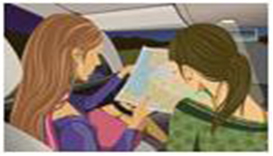
You should know where you are going and how you are going to get to your destination. This means you must plan your route in advance, whether driving to the store, work, or on a trip to the country. When you plan in advance, you tend not to make quick and dangerous last minute maneuvers. Planning ahead can prevent many serious difficulties even on routine, local trips. Selecting the right time to travel is important. Try to avoid rush hour traffic. It is a good idea to keep listening to local radio stations while driving so you are aware of traffic problems ahead. To become familiar with the area, check a local map before leaving. You should know ahead of time the destination, address, and what street to take. If you miss a street, do not try to make a split-second turn or attempt to stop; this is very hazardous. Go around the block and try again. If traveling on the freeway and you pass your exit, do not try to stop, cut-off, or endanger other cars with unsafe maneuvers. Just continue on to the next exit and then back track. If you have a nighttime vision problem, avoid driving at night.

When lost, stop and ask for directions; do not just drive blindly around. Never try to look at a map when your car is moving. Learn how to use a map effectively so you can easily plan out your stops intelligently. A good procedure when planning a trip is to draw a heavy line along your proposed route so that you can consult the map quickly.
18 Road Trip Planning Suggestion Tips:

Let’s start with the basics
First aid kit, flashlight, blanket, GPS navigation aid, warm clothing comfortable shoes.
Road trips can be fun if planned accordingly. They can be a memorable adventure. Done wrong, it can be a nightmare and your worst experience ever.
1.Vehicle maintenance.
Make sure your vehicle has gone through a detail check and it is fully ready for you road-trip. Make sure you have changed the oil in your vehicle and the windshield wiper fluid is full. Have your registration and insurance papers with you and are up to date.
2.Pick the right companionship.
Make sure you pick the right friends or family members to travel with. You want to have a memorable trip not a miserable one.
3. Take turns driving.
Be flexible and allow other drivers to assist with the driving. You need to enjoy sightseeing too. Preplan the driving routes so all the drivers will be able to assist with this project.
4. Bring your own music.
You want to enjoy your time while driving, take your favorite music with you; take a good variety if you are planning a long road trip. If your music is not pleasurable your drive will be boring. Prepare a nice mix of variety, surprise yourself! Take some sing-alongs with you and have fun with your family/friends singing along.
5. Sunglasses & Sunscreen.
Sunglasses significantly improve comfort and visual clearness by protecting the eyes from glare and, more normally, from excessive exposure to ambient light. Make sure you have your good sunglasses and have a spare one with you. Also, wear your daily sunscreen; you will burn through your car window.
6. Avoid stupid traffic tickets.
Don’t forget you are NOW on vacation and no reason to hurry or make irrational mistakes. Take your time and don’t rush and follow the rules:
- -Wear your seat belt
- -Use your turn signals
- -Don’t speed
- -Stay away from trouble
7. Bring your own food and drinks.
Pack some of your favorite and healthy goodies. Don’t pack too much sugar; since that sugar rush is not to your advantage! Pack up lots of water; when you are bored you get thirstier. And, the last thing you’ll need is a nagging kid that is thirsty!
8. Bring garbage bags.
To dispose of your tiny trash goodie wraps and water bottles, you definitely need trash bags. So you don’t get irritated with your car turning into a huge trash can; make sure garbage bags are handy in the car with you. For those organized and neat freaks, a well organize, de-cluttered road-trip is a happy road-trip.
9. Get gas before you’re on E.
Fill up your gas tank before you get on the freeway. Don’t take any chances with the next gas station; on the other hand, gas stations off the freeways are always more expensive; so save money and time fill it up before you hit the road!
10. Use the bathroom every time you stop.
You’ll definitely save time, you make think you don’t have to go; but you will! Don’t forget and remind all your passengers, “You don’t know when you’ll be able to go again!”
11. Plan time for unexpected stops.
You are not on a race; this is a fun and relaxing road-trip. Allow plenty of time for all unexpected stops and maximize on all stops with enjoyment. Pull over for sightseeing, or just a simple taking a fresh breath and even a nice stretch will be pleasant.
12. Sleep.
Rejuvenate when in need! When it’s not your turn to drive, take short naps. This is especially important if you are planning to drive more than 8 hours straight. Sleeping in the car can be comfortable with your favorite pillow. Don’t forget a well-rested driver is a safer driver.
13. Avoid rush hour traffic.
If possible, plan your course so you go through major cities outside of peak driving times. If that’s not possible, look for alternate routes. Don’t forget, you are on vacation; but the rest of the world is still working and commute their normal daily route.
14. Bring a map. A real, actual, paper map that does not talk to you.
Plan your route ahead of time and make sure to glance through your map (paper map with highlights) so you are more familiar with the upcoming roads. If you have a navigation system, you should program
your destination into it before you set out. While driving, if you need to take more than a cursory glance at your navigation materials, pull into a parking lot or find a safe place on the side of the road before you attempt to regain your bearing. Getting lost might be dangerous, but it’s nothing compared to getting in an accident on your vacation.
15. Pack games for the kids.
If traveling with kids, make sure you have all the tools to keep the entertained. Toys and games are your best tools while traveling with kids. Also another game we play when on road-trip is the Alphabet Game, my kids actually look forward to our road-trips because of this game.
16. Wear flip flops.
Make sure your feet are comfortable; pull out those flip flops, you’ll love them while driving. Flip flops are your best friends while driving long distances.
17. Checking Routes and Road Conditions.
Knowing beforehand where you’re going and how long it might take you to get there can save you a lot of time and anxiety. If there’s some sort of problem, you could easily wind up miles from help and have no idea which way to go. You also need to check the upcoming weather conditions so you are well prepared and ready to face the upcoming challenges.
Never start your vacation by drinking and driving-Get a DUI – Lose Your License!
It is illegal to drive with a Blood Alcohol Content (BAC) of .08% or more (.04% for commercial vehicle drivers and .01% if under 21). Other factors, such as fatigue, medications or food may affect your ability to legally operate a vehicle. The table below gives an estimate of blood alcohol levels based on the number of drinks consumed, gender and body weight. REMEMBER: Even one drink is likely to affect your ability to drive safely!
18. Have fun!
Yup! You planned this road trip for FUN! Make sure are having fun and start your vacation with fun and laughter. Don’t start your vacation with yelling at the kids, kicking the dog and slamming the doors. Finally, the victory of your road trip is dependent on your state of mind. Make sure you only think about how fun this road trip will be and not “Oh My God, we have to drive sooooo long!” So Relax, Smile and Enjoy.
When planning for trips always check the road conditions and any upcoming constructions (heavy congestion, collision, chains required, etc.)
When planning for trips to avoid any frustrating surprises inspect your vehicle for safety and don’t forget you never want to rush and allow extra travel time for utmost pleasure for your road trip.
AVOIDING PROBLEMS ON THE ROAD:

Be as Courteous While Driving as in Other Social Situations…
You must use good manners if you want to get along with other drivers on the road. Just because you are cut off from other drivers by walls of steel and glass is no reason to treat them any differently than if you were to meet them at a party.
It is estimated that drivers perform small and large illegal maneuvers about 400 times before they are caught. Each one is a source of irritation, inconvenience, and danger to others. A strategy we can all benefit from is to set a good example to others when driving.
The U.S. Department of Transportation has estimated that the average driver has a couple of close calls a month and an actual collision every 6 years. Many of these close calls and collisions occur because drivers refuse to be courteous to other drivers.
Maintaining a safe following distance
When another driver makes a mistake, you need time to react. Give yourself this time by keeping a “space cushion” on all sides of your vehicle. This space cushion will give you room to brake or maneuver if you need it.
Keep a Cushion Ahead
Many drivers don’t see as well as they should because they follow too closely (tailgate) and the vehicle ahead blocks their view of the road. Create a space cushion around your vehicle as you drive, and maintain at least a 3-second following distance (4-seconds if there are adverse traffic or weather conditions present). This will give you the extra space you need to maneuver or stop for a safer following distance.
Good drivers keep a safe following distance to see more clearly. The more space you allow between your car and the car ahead, the better. Most rear end collisions are caused by tailgating. To avoid this, use the “three-second rule.”
Keep enough space between your car and the car ahead so that you will have a “bigger picture” of what lies down the road and steering to avoid trouble will be easier. You can travel in the center of the lane instead of hugging one side or the other to let you see ahead. Most rear-end crashes are caused by following too closely. To avoid this, use the “three-second rule.”
Three-Second Rule & How it Works:
- Watch the vehicle ahead pass a fixed point, such as an overpass, sign, fence, corner or other marker.
- Begin counting off the seconds it takes you to reach the same place in the road. (Count “one-thousand-one, one-thousand-two, one-thousand-three”.)
- If you reach the mark before you have counted off three seconds, you’re following too closely. Slow down and increase your following distance.
- Remember, the three-second rule applies only in good weather and depends on the condition of your vehicle and the road. In bad weather conditions, heavy traffic, poor pavement or if your vehicle is in poor condition, add extra seconds to the three-second rule.
Sometimes you will need more than a “three-
second” cushion. At that point follow the
“three-second Plus” rule when:

- Crowded by a tailgater. Allow extra room between your car and the car ahead. Then, if you need to slow down you can do so gradually. You will be able to avoid braking suddenly – and being hit from behind by the tailgater!
- Driving on slippery roads. If the car ahead should slow or stop, you will need more distance to stop your car
- Following motorcycles. If the motorcycle falls, you’ll have to avoid hitting the rider. Motorcycles fall more often on wet or icy roads, on metal surfaces (i.e., bridge gratings, railroad tracks, etc.), and on gravel
- The driver behind you wants to pass. Slow down to allow room in front of your car, so the driver will have space to move into
- Pulling a trailer or carrying a heavy load. The extra weight makes it harder to stop
- Following large vehicles that block your view ahead. You need the extra room to see around the vehicle and to the sides.
- You see a bus, school bus, or a placarded vehicle. These vehicles must stop at railroad crossings. Expect the stops; slow down early to allow plenty of room.
- Merging on a freeway.
If you follow too closely and another driver “cuts” in front of you, the normal reaction is to slam on your brakes and swerve out of the way. Swerving out of the way most often results in cutting someone else off or possibly driving off the roadway. It might also result in the car behind you a crashing into you or other cars around you.
If another driver “cuts” in front of you, just take your foot off the gas. This will give you space between your car and the other driver without swerving into another lane.
Avoid driving in the Blind Spots of other vehicles
Blind Spot is the area around your vehicle in which you can see other people/vehicles through your mirrors. Always keep a space cushion on each side of your car.
Blind Spots
- Don’t drive in another driver’s blind spot. The other driver may not see your car and could change lanes and hit you.
- Avoid driving alongside other cars on multilane streets. Someone may crowd your lane or try to change lanes and pull into you. Move ahead of the other car or drop back.
- The area’s most commonly referred to as blind spots are the rear quarter blind spots, areas towards the rear of the vehicle on both sides. Vehicles in the adjacent lanes of the road may fall into these blind spots, and a driver may be unable to see them using only the car’s mirrors.
- Other areas that are sometimes called blind spots are those that are too low to see behind and in front of a vehicle. Also, in cases where side vision is hindered, areas to the left or right can become blind spots as well.
Planning for an evasive action:
Always think What If….
- Keep as much space as you can between yourself and oncoming traffic. On multilane streets, stay out of the lane next to the centerline, if you can. That way you will have more room to avoid an oncoming car that suddenly swerves toward you.
- If possible, make room for vehicles entering freeways even though you have the right-of-way.
- At freeway exits, don’t drive alongside other cars. A driver on the freeway may pull off suddenly or a driver leaving the freeway may swerve back on
- Keep a space between yourself and parked cars. Someone may step out from between them. A car door may open. A car may pull out suddenly.
Driving with your headlights on during the day will increase your visibility while driving.
When it is cloudy, raining, snowing, or foggy; or better yet if weather conditions require you to use your windshield wipers, you must turn on your low-beam headlights, and defroster.
- On frosty mornings, when other drivers’ windows may be icy or “fogged.”
- Any time conditions (clouds, rain, snow, dust, smoke, fog, etc.) prevent you from seeing other vehicles. Other drivers may have trouble seeing you, too.
- On small country or mountain roads, even on sunny days. This helps other drivers see you and may help you avoid a head-on crash.
- When necessary to get another driver’s attention.
- All cars need be equipped with at least two headlamps located at least one on each side of the front of the vehicle, and, except as to vehicles registered prior to 01/01/1930, they must be located right above or in advance of the front axle of the vehicle. The headlamps and all the lights in any headlamp unit should be at a height of not more than 54 inches or less than 22 inches.
- All motor vehicles should be able to operate during darkness or inclement weather or both with at least two lighted headlamps that comply with subdivision discussed above (e).
- As used in subdivision (f), “inclement weather” is a weather condition that is either of the following:
- A condition that prevents a driver of a motor vehicle from clearly seeing a person or another motor vehicle on the highway within 1,000 feet.
- A condition requiring the windshield wipers to be in continuous use due to rain, mist, snow, fog, or other precipitation or air moisture.
Turns
Left turns– To make a left turn, drive close to the center divider line or into the left turn lane. Begin signaling about 100 feet before the turn. Look over your left shoulder and reduce your speed. Stop behind the limit line. Look left, and then right, then left again, and makes the turn when it is safe. When you turn left, do not turn too soon and “cut the corner” of the lane belonging to the vehicles coming towards you.
Example of a left turn:
Safety suggestion:
While waiting to turn left, keep your wheels pointed straight ahead until it is safe to start your turn. If your wheels are pointed to the left and a vehicle hits you from behind, you could be pushed into oncoming traffic.
A left turn against a red light can only be made from a one-way street onto a one-way street. Signal and stop for a red traffic light at the marked limit line. If there is no limit line, stop before entering the crosswalk. If there is no crosswalk, stop before entering the intersection. You may turn left into a left-moving, one-way street if there is no sign to prohibit the turn. Yield to pedestrians, bicyclists, or other vehicles moving on their green light.
Right turns–To make a right turn, drive close to the right edge of the road. If there is a bike lane, drive into the bike lane no more than 200 feet before the turn. Watch for bicyclists or motorcyclists who may get between your vehicle and the curb.
Begin signaling about 100 feet before the turn. Look over your right shoulder and reduce your speed. Stop behind the limit line. Look both ways and turn when it is safe. Do not turn wide into another lane. Complete your turn in the right lane.
Example of a right turn:
Right turn against a red light– Signal and stop for a red traffic light at the marked limit line. If there is no limit line, stop before entering the crosswalk. If there is no crosswalk, stop before entering the intersection. You may turn right if there is no sign to prohibit the turn. Yield to pedestrians, motorcyclists, bicyclists, or other vehicles moving on their green light.
No turn against a red arrow–You may not turn right or left against a red arrow.
Examples of Right and Left Turns:
The numbers on the cars in the diagrams refer to the numbered sentences on these pages. Always use your turn signals.
1. Left turn from a two-way street. Start the turn in the left lane closest to the middle of the street. Complete the turn, if safe, in either lane of the cross street (shown by the arrows). Use the center left turn lane if one is available. A left turn may be made from the other lane, if permitted by signs or arrows.
2. Right turn. Begin and end the turn in the lane nearest the right hand curb. Do not swing wide into another lane of traffic. Watch for pedestrians, motorcyclists, and bicyclists between your vehicle and the curb. Sometimes, signs or pavement markings will let you turn right from another lane as shown by the graphic 2.
3. Left turn from a two-way street into a one-way street. Start the turn from the lane closest to the middle of the street. Turn into any lane that is safely open, as shown by the arrows.
4. Left turn from a one-way street into a two-way street. Start the turn from the far left lane. Turn into either of the lanes that are safely open, as shown by the arrows.
5. Left turn from a one-way street into a one-way street. Start the turn from the far left lane. Watch for pedestrians, motorcyclists, and bicyclists between your vehicle and the curb because they can legally use the left turn lane for their left turns. Turn into any lane that is safely open, as shown by the arrows.
6. Right turn from a one-way street into a one-way street. Start the turn in the far right lane. If safe, you may end the turn in any lane. Sometimes, signs or pavement markings will let you turn right from another lane, as shown by the graphic 6.
7. Turn at a “T” intersection from a one-way street into a two-way street. Through traffic has the right-of-way. You may turn either right or left from the center lane. Watch for vehicles, motorcyclists, and bicyclists inside your turn.
Legal U-Turns
A U-turn is turning your vehicle around in the street to go back the way you came. To make a U-turn, signal and use the far left lane or the center left turn lane.
You may make a legal U-turn:
- Across a double yellow line when it is safe and legal.
- In a residential district:
- If there are no vehicles approaching you within 200 feet.
- Whenever a traffic sign, light, or signal protects you from approaching vehicles.
- At an intersection on a green light or green arrow, unless a “No U-turn” sign is posted.
- On a divided highway, only if an opening is provided in the center divider.
Some examples of illegal U-Turns:
- In front of fire stations
- Where you do not have an unobstructed view of the roadway for at least 200 feet in both directions
- On one-way street
- A sign “No U-Turn” is posted
Use Your Emergency Signals
Vehicles are equipped with emergency flashers which alert other drivers that stopped or slow moving traffic is ahead. When flashers are enabled, all four turn signals lights flash at once alerting everyone. In case of a collision ahead, your brake lights will provide adequate warning that vehicles are slowing or stopping; however additional steps may be taken to warn the drivers behind you by turning on your emergency flashers or tapping your brake pedal quickly three or four times. If you are having problems turning on your emergency flasher, use the hand signal when slowing and stopping.
Never make a spontaneous stop on the road, unless necessary for safety or to obey a law. If you need to stop, then slow down first to warn the driver behind that you will be coming to a full stop. If your vehicle breaks down on the road, make sure that other drivers can see it by turning on your emergency flasher and be visible. If you are having problems with your vehicle and need help, follow these steps:
- Pull off to the side of the road and enable your vehicle’s emergency flashers.
- If you cannot get completely off the road, make sure your position is a safe one by being visible by all the other drivers from both sides.
- Make sure your emergency flashers are activated if you are not moving. If your vehicle doesn’t have emergency flashers, turn signals may be used instead.
- You can also lift the hood to signal an emergency.
- Take all precautionary steps to warn other drivers by placing emergency flares or triangles 200–300 feet behind the vehicle. This allows other drivers enough time to change lanes safely, if needed. Also make sure there are no flammable liquids close to you before using flares.
- Make sure to stay off the road until help arrives.
Remember: Do not try to change a tire if it means you have to stand in a traffic lane.
Scanning for hazards
Scanning
Scan your surrounding area before making any turns; first scan your route for vehicles, bicyclists, and pedestrians. Also look at stationary hazards, such as construction on the road, stalled or parked vehicles, wrecks, or even trash. You need to be wary of other drivers as well; if they make any mistakes, you need to have enough time to react; thus you need to keep a safe distance around your vehicle.
Know What Is Ahead
You need to look down the road 10–15 seconds ahead of your vehicle so you can see hazards early. As you scan ahead, be alert for vehicles around you. Be cautious of pedestrians or parked vehicles. Particularly at an Uncontrolled Intersection; you should slow down and be prepared to stop for other vehicles, bicyclists and pedestrians that are already crossing the intersections or even appear by jumping on the street unexpectedly.
Where is the green vehicle headed?
Be cautious of drivers ahead of you. In this picture the green vehicle ahead of is swerving on the road; there could be multiple reasons. Since we don’t have enough time to guess the reasons, we need to always make sure to have ample space to come to a full stop. The driver ahead might be intoxicated. Or, he/she may be inattentive or occupied by any number of distractions: Children, a phone conversation, a conversation with the passenger, music, food or …. Regardless of the ultimate cause of the erratic driving, a defensive driver’s response is considerably the same.
When traffic is moving at 30 mph in the city, you need to have a safe distance of approximately half a city block from the vehicle ahead of you and on the open highway you need about a full block distance.
Take in the whole scene– Don’t only look at the middle of the road, you need to be cautious of your sides and behind as well. Scanning helps you to see:
- Other vehicles and pedestrians that may be in the road by the time you reach them.
- Upcoming problems ahead.
- The upcoming signs giving directions.
The shaded areas are your blind spots.
Don’t forget you are not the only drive on the road, before changing lanes, look at your side mirrors, rear view mirror and your shoulder to check for blind spots. You must verify that these areas are clear before making a lane change in order to make sure that you will not hit another vehicle or pedestrian. For similar reasons, you should make sure not to drive in another driver’s blind spot.
Watch for hazards–Defensive drivers have great visual habits while driving. They have a habit of periodically check their side mirrors and front mirror as well as scanning the entire driving environment to remain aware of what is going on all round their vehicle. Just be watchful for unexpected hazards!
Do not be a tailgater! Many drivers follow too closely (tailgate) and are not able to see as far ahead as they should because the vehicle ahead blocks their view. The more space you allow between your vehicle and the vehicle ahead, the more time you will have to see a hazard, and stop or avoid that hazard.
Most rear end collisions are caused by tailgating. To avoid tailgating, use the “three-second rule.” When the vehicle ahead of you passes a certain point such as a sign, count “one thousand- one, one-thousand-two, one-thousand-three.” This takes about three seconds. If you pass the same point before you finish counting, you are following too closely.
You should allow a four-second or more cushion when:
- Being crowded by a tailgater. Allow extra room ahead, do not brake suddenly. Slow down gradually or merge into another lane to prevent being hit from behind by the tailgater!
- Driving on slippery roads.
- Following motorcyclists on wet or icy roads, on metal surfaces (e.g., bridge gratings, railroad tracks, etc.), and on gravel. Motorcyclists can fall more easily on these surfaces.
- The driver behind you wants to pass. Allow room in front of your vehicle so the driver will have space to move in front of you.
- Towing a trailer or carrying a heavy load. The extra weight makes it harder to stop.
- Following large vehicles that block your view ahead. The extra space allows you to see around the vehicle.
- You see a bus, school bus, or a placarded vehicle at railroad crossings. These vehicles must stop at railroad crossings, so slow down early and allow plenty of room.
- Merging onto a freeway.
If you follow too closely and another driver “cuts” in front of you, just take your foot off the gas. This gives you space between your vehicle and the other driver, without having to slam on your brakes or swerve into another lane.
Know What Is At Your Side
As you start driving and looking ahead and behind you, make sure you also are aware of your sides and have a good control over your side distance with other vehicles. You should always look to the left and right sides of your vehicle when changing lanes or making turns. Never assume the other drivers can see you and you are safe; as a matter of fact, we highly recommend to always assume your vehicle is on the blind spot of other vehicles and practice extreme caution when driving in congested streets.
At Controlled intersections:
Controlled intersections are the ones that are controlled by signs or signals regulate how and when traffic may move through them. Traffic controls persuade an orderly flow of traffic and limit confusion at busier crossroads. Drivers must still use their own decision-making powers to make certain moves and turns by
taking advantage of the opportunities offered by traffic controls. Drivers should never proceed blindly through any intersection.
When green lights turn yellow, drivers need to slow down the red signal is about to appear. If you find yourself in the middle of the intersection, you may continue to drive through the intersection. If you have not yet entered the intersection when the light turns yellow, a yellow signal light means “CAUTION.” The red signal is about to appear. When you see the yellow light, stop if you can do so safely. If you cannot stop safely, cross the intersection cautiously.
When you need to turn right at a red light, you must first bring your vehicle to a complete stop at the intersection, and check for all incoming traffic or any pedestrians crossing the street; when safe you make your right turn. Also look out for warning signs “NO TURN ON RED”, don’t turn on red; it is also illegal to make a right turn on a red arrow.
At Uncontrolled Intersections:
An uncontrolled intersection lacks the useful direction of traffic control procedure (i.e., signs, signals). Because motorists are not faced with a traffic control, it is not uncommon for them to erroneously assume that they “have” the right-of-way at an uncontrolled intersection. Safe cautionary driving protocol with other users of the roadway is always up to each individual driver. When approaching uncontrolled intersections, drive slowly and carefully, especially where visibility is imperfect.
At an uncontrolled intersection, if two or more vehicles arrive at the same time the driver to the right has the right-of-way. And the rule of first come first serve applies and any driver that is already in the intersection must be given the right-of-way. Any vehicle that is already in the intersection must be give the right-of-way that rule applies to ANY type of intersection. (21800, CVC)
At T-intersections (streets with one through street and two side streets that must merge with the through street), vehicles on the through road have priority. A T-intersection is so named because it looks like an upper case “T”.
Uncontrolled intersections present a real danger. You should slow down and be ready to stop for other vehicles, bicyclists, and pedestrians that are already crossing the intersection.
Traffic Breaks
Traffic breaks are used by law enforcement to:
- Slow or stop traffic to remove hazards from the roadway.
- Conduct emergency operations.
- Prevent traffic collisions in heavy fog or unusually heavy traffic.
During a traffic break, the officer turns on the rear emergency lights, slows the vehicle, and drives across the lanes of traffic in a serpentine manner. To assist the officer in conducting a traffic break:
- Activate your emergency flashers to warn other drivers there is a hazard ahead.
- Slowly begin to decrease your speed. Do not slow abruptly unless it is necessary to avoid a collision. Slow to the same speed as the officer while keeping a safe distance from the patrol vehicle ahead of you.
Do not attempt to drive past the patrol vehicle. Do not accelerate until the patrol vehicle has turned off its emergency lights and traffic conditions ahead allow the return to normal speeds.
Know What Is Behind You
It is very important to check behind and your side mirrors before:
- Changing your lanes. Look in the mirrors first and look over your shoulder to make sure you are not getting in the way of vehicles in the lane you are entering and you are not in the blind spot of the other drivers.
- Driving down a steep hill. Always keep more distance when you are driving down on a steep hill.
- Backing out-Always back out cautiously. Don’t forget you really don’t have a clear vision of your back so if you drive slowly; you have more control to stop if needed. Backing out is always a dangerous move.
- Check traffic behind you often to know if you are being tailgated (another driver is following too closely). If you are being tailgated, be careful! Brake slowly before stopping. Tap your brakes lightly a few times to warn the tailgater you are slowing down.
It is safer to “Lose” the tailgater as soon as you can. Change lanes and allow the tailgater to pass you, or slow down to allow enough “cushion” between you and the car in front of you. If this does not work, pull off the road when it is safe and let the tailgater pass and as you pull aside and you have a cell phone, take it out and get ready to call a friend or family member; this action normally dissuade the tailgater for any possible physical actions against you.
Clean Windows and Mirrors
Keep your windshield and side windows clean inside and out. Bright sun or headlights on a dirty window make it hard to see out with a heavy glare. Clear any ice, frost, or dew from all windows before you start your drive.
Make sure you can see and be seen by others. If you drive in rain or snow, and you are experiencing heavy snow or mud splashed on your windows, you must stop and wipe your windows, windshield, headlights, and taillights for a more clear visibility.
Adjust Seat and Mirrors
Anytime you get in a new car adjust your seat before you put on your seat belt. You should sit high enough to see the road. If you still cannot see, use a seat cushion. You also need to adjust side and rear mirrors before you start driving. If your vehicle has a day/night mirror, learn how to use it.
How Well Can You Stop?
Always ask yourself if someone jumps in front of my car, how well can I stop?
- At 55 mph, it takes about 400 feet to react and bring the vehicle to a complete stop.
- At 35 mph, it takes about 210 feet to react and bring the vehicle to a complete stop.
Don’t forget you always need to adjust your driving speed to the weather and road conditions. Turn on your lights during the day, if it is hard to see or you cannot see at least 1,000 feet ahead of you.
Looking for Trouble
Nothing you do will guarantee that other drivers will see you. The only eyes you can really count on are your own. A good rider is always “looking for trouble”—not to get into it, but to stay out of it.
Scan— search aggressively for potential hazards. Looking ahead for hazards and potential escape routes is especially critical at intersection.
Identify—locate hazards and potential conflicts, which include:
- Cars, trucks, and other vehicles. They share the road with you and move quickly. Your reactions to them must be quick and accurate.
- Pedestrians and animals. They are unpredictable and make short quick moves.
- Stationary object. These include potholes, guard rails, bridges, roadway signs, hedges, or rows of trees. They will not move into your path, but may influence or complicate your riding strategy.
Predict— anticipate how the hazard may affect you. Speed, distance, and the direction in which the hazard is moving are important. Estimate the consequences of the hazard. How might the hazard—or your effort to avoid it—affect you and others.
Decide—which of the three things you can do to reduce the hazard:
1. Communicate your presence. This is the most passive action you can take since it depends on the response of someone else. Use your lights and horn, but don’t rely on the actions of others.
2. Adjust your speed. Accelerate, slow down, or come to a stop.
3. Adjust your position. Change lanes, lane position, or completely change direction to adjust your position. This will depend on the nature of the hazard and how much time and space you have.
Execute—carry out your decision. Your riding skills should be second nature to you. Even the best decision is meaningless if you do not have the skills to carry it out. Know your limits and ride within them.
Scanning for hazard continues by…
The best way to stay out of trouble is to see it coming. Experienced riders make a practice of looking well ahead. In the city, they are always looking from one-half to a full block ahead. On the highway, they look about as far ahead as they can see clearly, giving themselves plenty of time to adjust to problems. They avoid panic stops or sudden swerves that can cause even more trouble.
- Keep checking the road surface ahead for slippery spots, bad bumps, broken pavement, loose gravel, wet leaves, or objects lying in the road. Curves and ramps are known collectors of oil and gravel.
- Use your height advantage. Look over or through the vehicle in front of you for vehicles stopping or turning ahead.
- Check the roadside. Watch for vehicles that may leave the curb or enter from side streets or driveways. In heavy traffic look for places where you can leave the road in a hurry if needed.
Enhancing driving with aids
During the day wearing of sunglasses is highly recommended to avoid the extreme sunlight blinding your eyesight. Modern vehicles are so well equipped, wondrous machines, and humans are incredibly adaptable creatures. Still, certain gadgets and devices can be used to make the driving experience safer and more comfortable.
Windshield Water Repellent
To boost visibility, always use your wipers to keep your windshields free of moisture and keep clear of dirt/dust. Synthetic, surface-applied water repellents may be used to coat automotive glass with a hydrophobic film. While these valuable aftermarket products are most often applied to a vehicle’s windshield, they can be used on any window. They encourage water to bead and roll off of the glass more easily, often without the need for windshield wipers. While these products are normally easy to use, they must be reapplied periodically to remain effective.
Sunglasses
Drivers are faced with some nature challenges while driving. When driving in bright, sunny conditions-especially when driving into the sun-use your sun visors; look away from the light source to keep from being temporarily blinded. Use your peripheral vision to track other vehicles since sunlight reflected from their surfaces can dazzle you.
Sunglasses improve comfort and visual clarity by protecting the eyes from glare and more generally from excessive exposure to ambient light. Just remember never wear sunglasses at night since it blinds your vision.
Convex Mirrors
We are all familiar with the “objects in mirror are closer than they appear” warning that appears on vehicles’ passenger-side mirrors; movies have even made jokes at its expense. The warning is used to draw drivers’ attention to the distorting effects of these convex mirrors on distance perception. While images in convex mirrors appear somewhat diminished and warped, these mirrors are preferred for use in vehicles because they present an upright image that provides a wider field of view than is possible with a “standard” mirror. Having a “fish eye” on your automobile will allow you to see a larger area to the rear of the vehicle. Convex mirrors help all drivers, but can be especially useful to older drivers or to others with limited strength or flexibility.
Audible Back-Up Warning
Audible Back-Up warning is a device that emits perceptible beeps, chirps, or a spoken warning when a vehicle’s reverse gear is engaged. These warning systems serve to notify pedestrians and other drivers in the surrounding area of an equipped vehicle that the vehicle is backing up and that they should keep clear. These devices are especially useful for larger vehicles that have limited visibility to the rear. Advanced systems can even self-adjust to emit a sound that is slightly louder than the ambient noise level.
Also uses of all the above devices are highly recommended to enhance your driving.
Giving up your Right-of-Way
Drivers are responsible to do whatever they must do in order to avoid a crash and deter from dangerous situations. There are times when you may “have the right-of-way, but other drivers, a bicyclist, or pedestrian moves in such a way as to cut you off. Whenever you would be in danger of getting into a collision with another user of the roadway by exercising your right to proceed, you should surrender your right-of-way to the other party.
Based on The California Highway Patrol, 2008 Annual Report:
Drivers in Fatal Collisions & Number of People That Were at Fault
“Mike, Slow down. I’m scared. We’ll get there when we get there!”
Mike is in a hurry to get Sara to work, but little does Mike know…He’s driving 75 MPH in a 55MPH Zone. If he doesn’t slow down, Sara’s worst fear of getting a traffic ticket will be realized. Mike needs to SLOW DOWN!
Did you know that…
4 in 2008, 612 people in California died in speed-related crashes. They were driving over 35mph – that’s almost 20% of the people who died of traffic-related collisions!
Responsible driving counts!


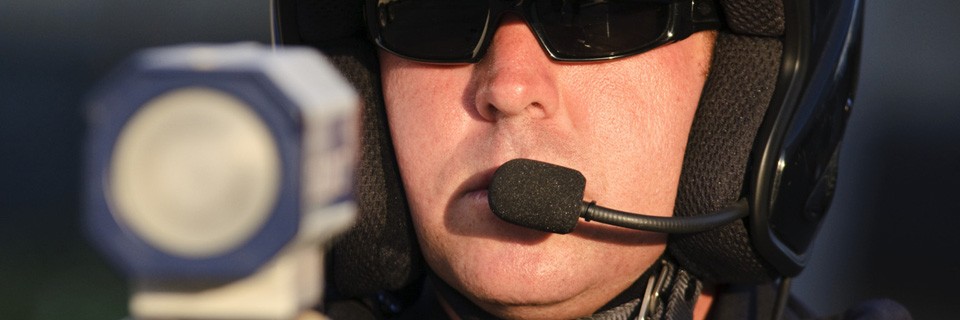


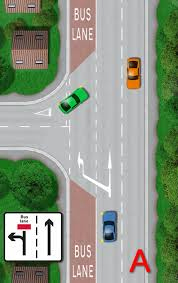
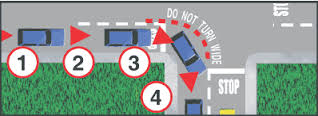
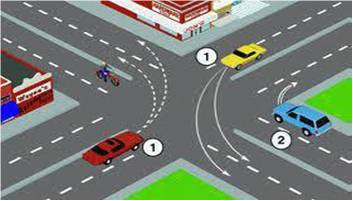
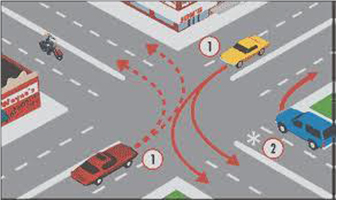





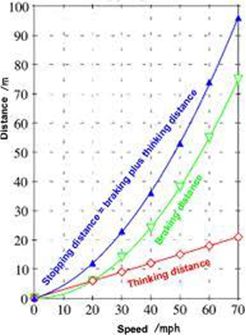
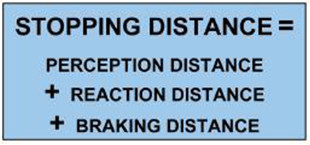

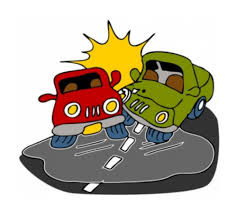
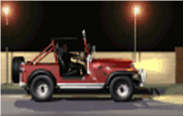
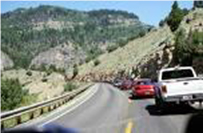

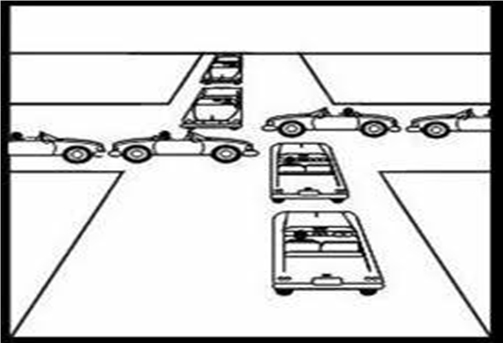
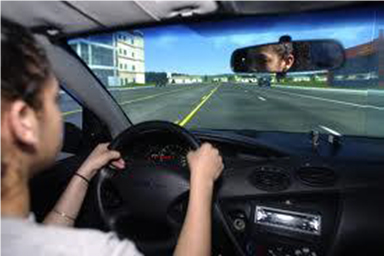

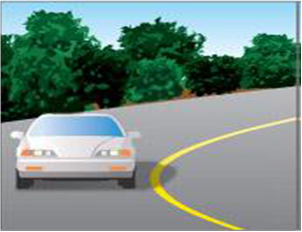
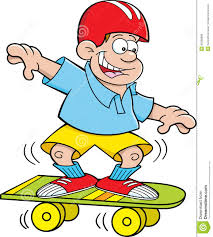






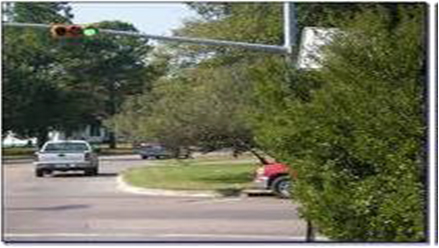
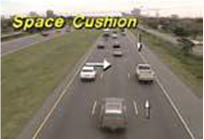
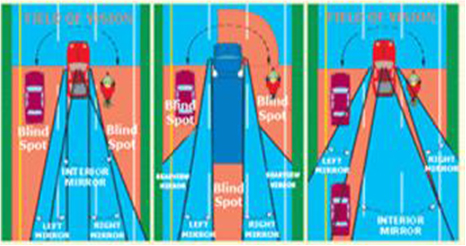
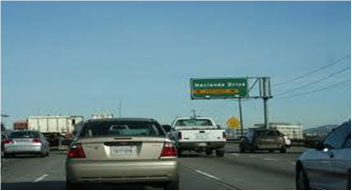


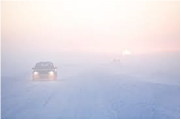
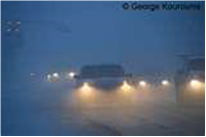

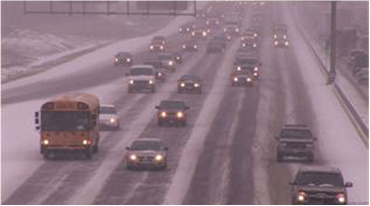

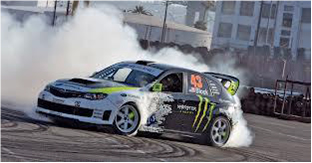







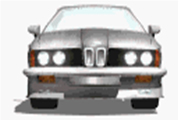
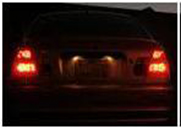



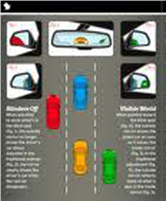
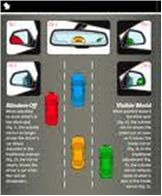
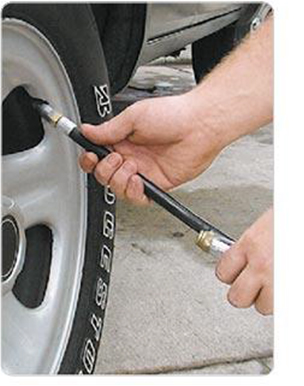
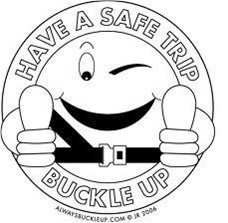
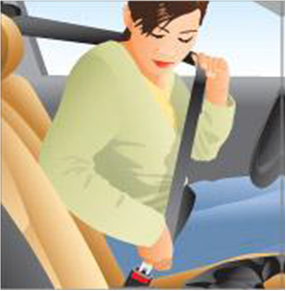
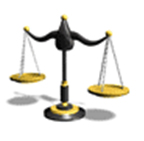
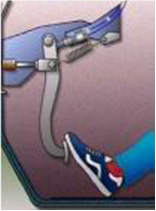
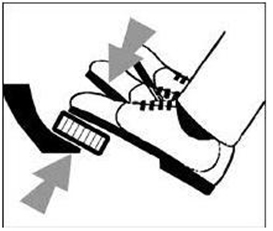
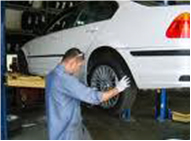
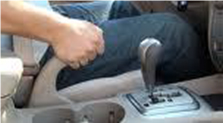




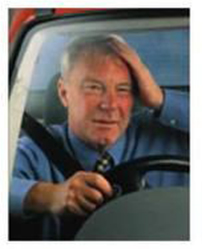




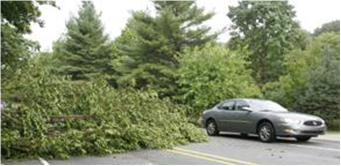
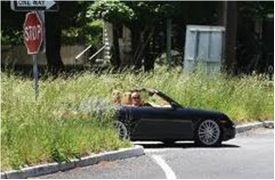
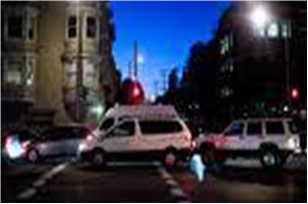
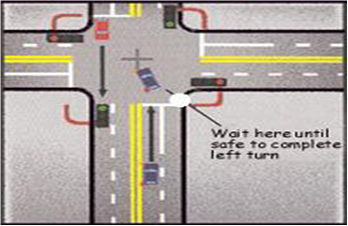

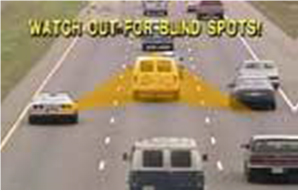
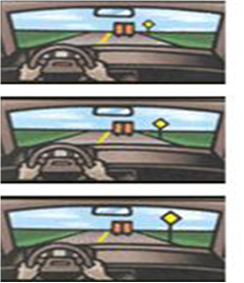
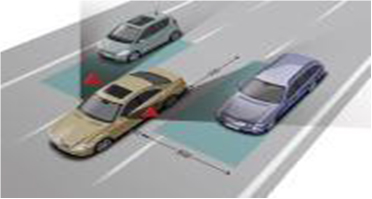
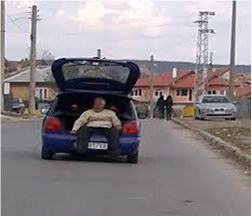
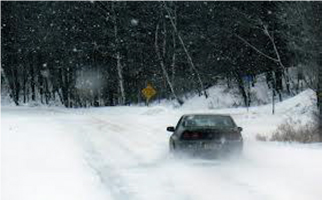

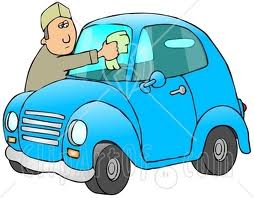

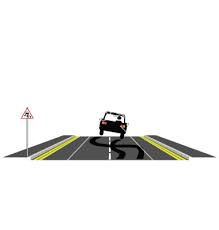

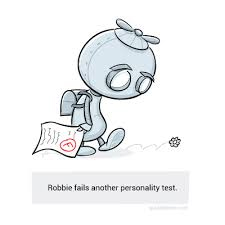
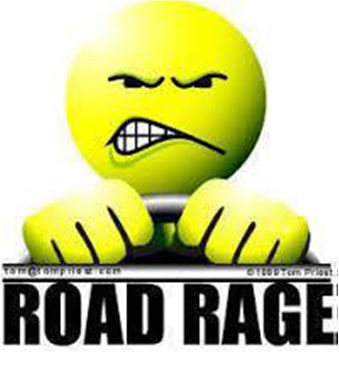
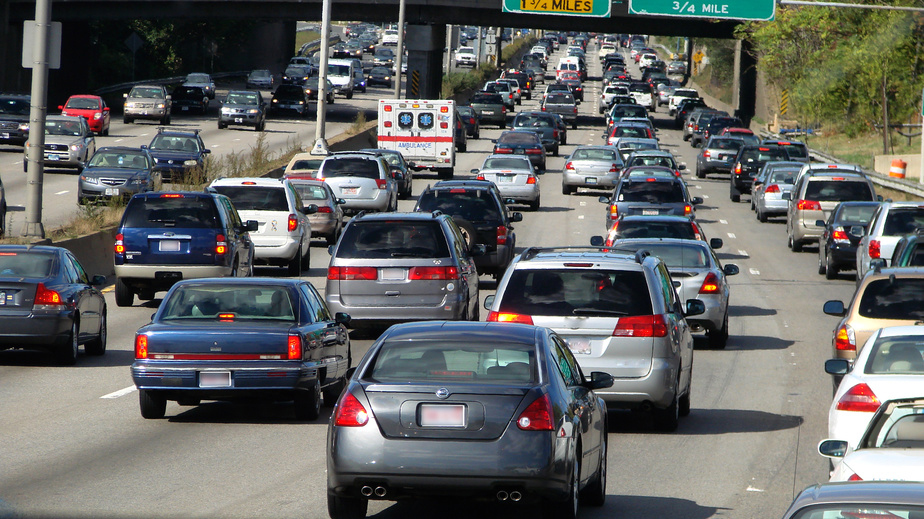

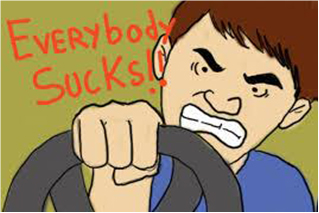

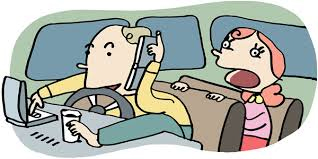

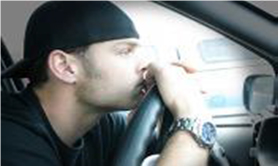

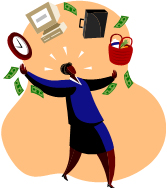
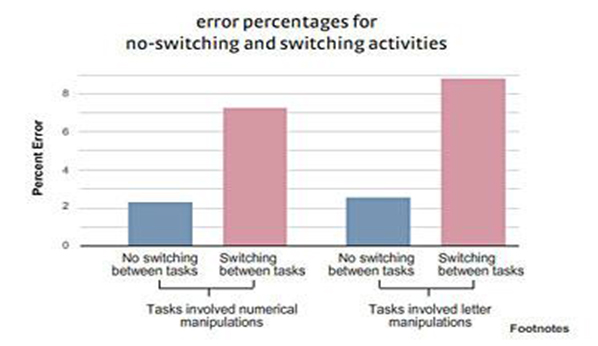


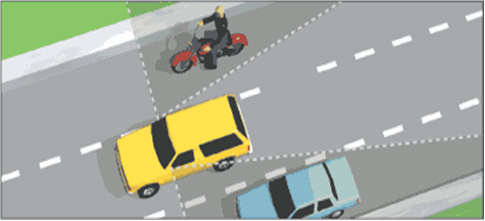
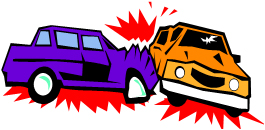
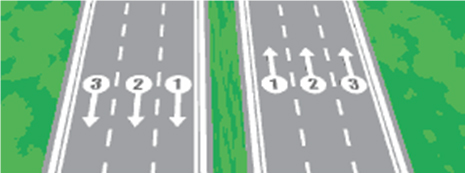


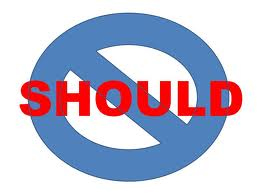



 When lost, stop and ask for directions; do not just drive blindly around. Never try to look at a map when your car is moving. Learn how to use a map effectively so you can easily plan out your stops intelligently. A good procedure when planning a trip is to draw a heavy line along your proposed route so that you can consult the map quickly.
When lost, stop and ask for directions; do not just drive blindly around. Never try to look at a map when your car is moving. Learn how to use a map effectively so you can easily plan out your stops intelligently. A good procedure when planning a trip is to draw a heavy line along your proposed route so that you can consult the map quickly.
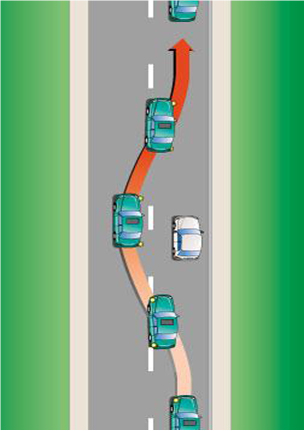
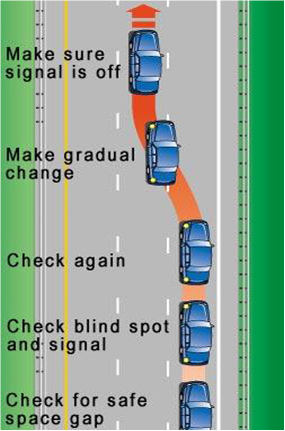

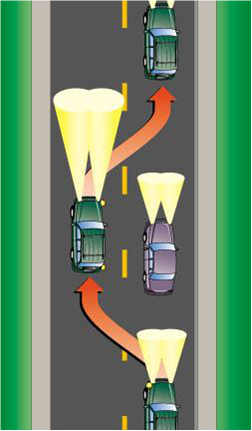
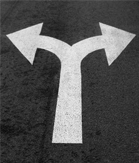




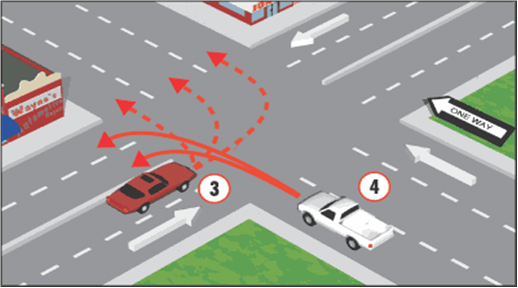
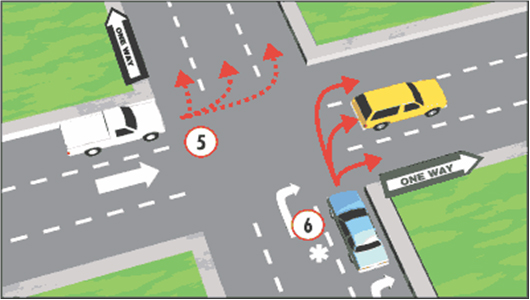
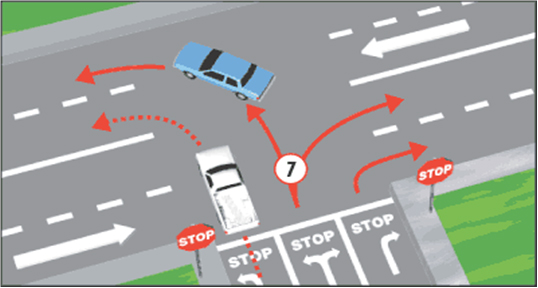


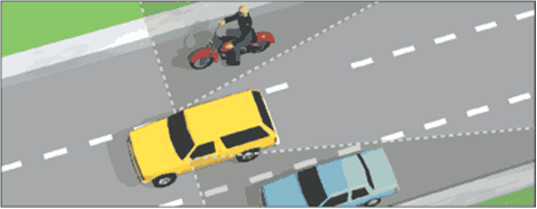








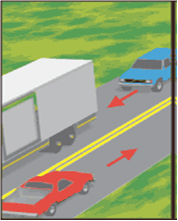
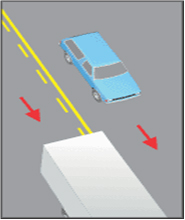
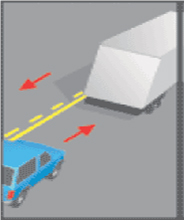
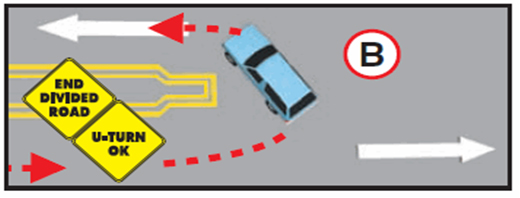

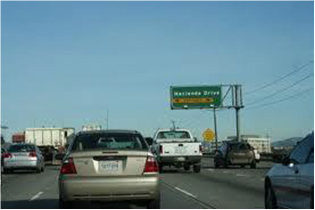
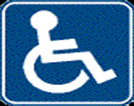
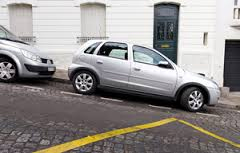
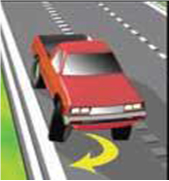
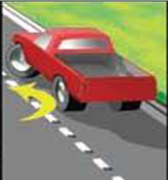
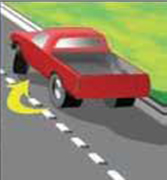

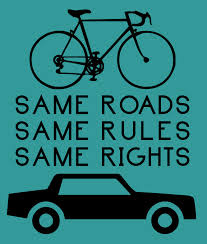

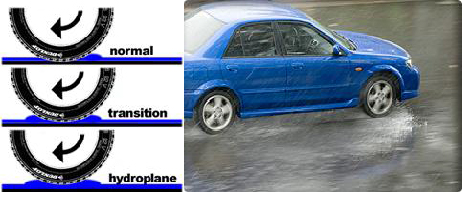
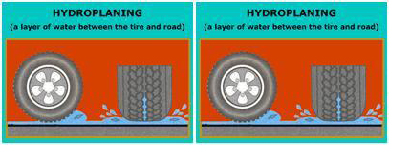

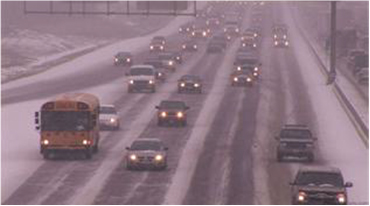 Stay only on the paved portion of the roadway and follow the tracks of the vehicle that you are traveling behind or the tracks that are established from previous traffic. When it is snowing, raining, or the road is icy, the tracks of the previous traffic will provide more traction for you to drive upon, reducing your possibility of skidding off the roadway. You may still encounter bad spots that could cause your vehicle to spin or skid, however it can help since other vehicles have groomed the tracks.
Stay only on the paved portion of the roadway and follow the tracks of the vehicle that you are traveling behind or the tracks that are established from previous traffic. When it is snowing, raining, or the road is icy, the tracks of the previous traffic will provide more traction for you to drive upon, reducing your possibility of skidding off the roadway. You may still encounter bad spots that could cause your vehicle to spin or skid, however it can help since other vehicles have groomed the tracks. Never pass vehicles on your right (of course, there are always exception to the rules); there are situations when passing on the right is allowed, such as (VC 21754):
Never pass vehicles on your right (of course, there are always exception to the rules); there are situations when passing on the right is allowed, such as (VC 21754):
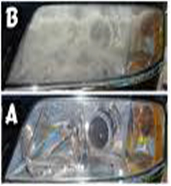

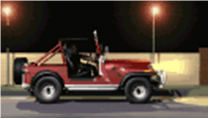
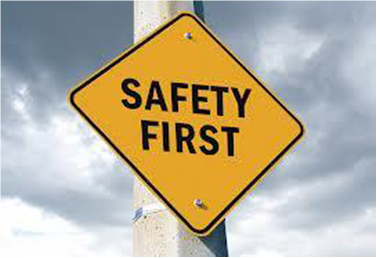
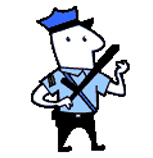
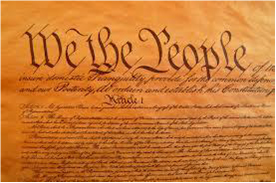

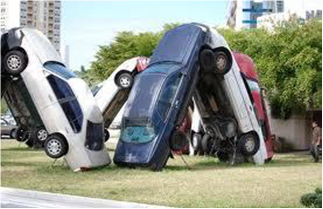



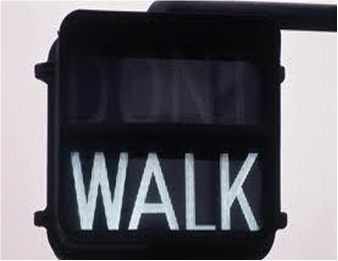
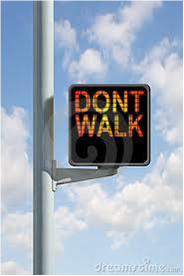
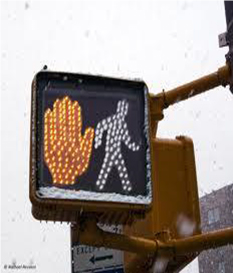
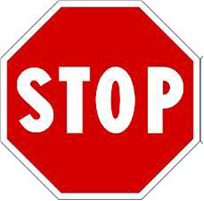
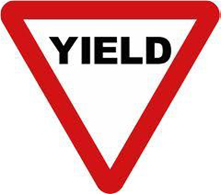


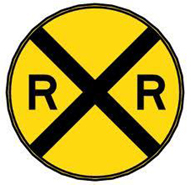

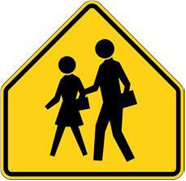

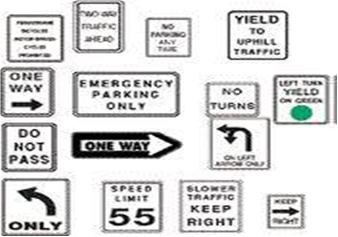


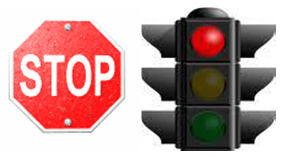
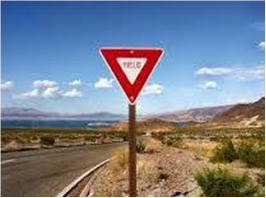

















section: